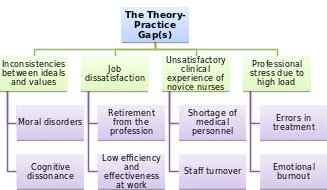Introduction
The nursing sector is one of the most complex and responsible public areas. Undoubtedly, in the process of treating and caring for patients, there are various kinds of difficulties, complications, and obstacles that even an experienced nurse can not always foresee. Nevertheless, this is not a reason to surrender and take such moments to heart, on the contrary, any mistake gives a valuable lesson and a path to self-improvement. This essay aims to study a specific case, define such a concept as “the gap between theory and practice,” and analyze nursing and its processes.
A Plan to Address Nursing Theory Gaps
Based on the scenario, it is recommended to eliminate the following gaps in nursing theory. For example, according to Montrief et al. (2018), coronary artery bypass graft, in most cases, entails adverse consequences in the form of complications, coupled with other types of diseases. Following this, there was a need to implement radical treatment methods and prevent the first signs of pneumonia. Hence, the nurse who takes care of the “critical patient” should provide an examination of the man in the intensive care unit and consult with the surgical team (Montrief et al., 2018). Furthermore, instilling saline worsens the oxygenation and extensibility of the lungs; oxygen tension occurs and saturation of mixed blood (McKinley et al., 2018). The introduction of saline solution in order to dilute secretions is not an acceptable practice for the experienced nurse. Consequently, in this case, theory, research, and practice have a fairly close, deep, and inextricable connection. If the attending nurse had focused on the comprehensive treatment of the man’s complications after surgery, the colleague would not have intervened in the situation if she had previously known the expected consequences.
Defining the Theory-Practice Gap
The theory-practice gap is a case that arises in such a circumstance when medical professionals seek to integrate student knowledge with real practical activities actively. This “break” is a kind of universal problem in the field of healthcare and nursing (Safazadeh et al., 2018). According to research, a potential breakup usually leads to cognitive dissonance or moral disorders (Greenway et al., 2019). Moreover, as standards of practice and medical care are in continuous development and improvement, it may seem that there is a gap between best and actual, current practice. Such a significant problem in the medical field also may reflect poor-quality service and patient care.
A Concept Map (Diagram)

Alignment of Nursing Theory
One should note that nursing theory is a complex discipline designed to answer the most common nursing science and practice questions. Moreover, the nursing theory often interacts with the process of nursing as follows. Primarily, the nursing process is the core of nursing education and creates a theoretical scientific basis for nursing care. In addition, the theory studies the regularities of nursing care organization, and scientific research in this area formulate nursing models, the rights and duties of nurses at all levels of status, and education. In order to implement an individual care plan, a nurse needs to have knowledge of exceptional care standards, manipulation standards, procedures and focus on the standard model of the nursing process. Studying the theory and realizing the main aspects of nursing processes, a specialist develops critical thinking and looks at the situation from different angles and sides. A nurse reflects, analyzes, and draws certain conclusions from their findings. Such elements help make more informed decisions in practice while avoiding possible mistakes.
Conclusion
In conclusion, in accordance with the indicated scenario, one can note that a vivid manifestation of the gap between theory and practice has been revealed in this case. This is a rather complex and contradictory phenomenon, implying a correlation between academic knowledge and real practice. Moreover, there is a fairly close connection between nursing theory and medical processes, which together form critical thinking and ensure the implementation of competent decisions.
References
Greenway, K., Butt, G., & Walthall, H. (2019). What is a theory-practice gap? An exploration of the concept. Nurse Education in Practice, 34, pp. 1-6. Web.
McKinley, D. F., Kinney, S. B., Copnell, B., & Shann, F. (2018). Long-term effects of saline instilled during endotracheal suction in pediatric intensive care: a randomized trial. American Journal of Critical Care, 27(6), pp. 486-494. Web.
Montrief, T., Koyfman, A., & Long, B. (2018). Coronary artery bypass graft surgery complications: A review for emergency clinicians. The American Journal of Emergency Medicine, 36(12), pp. 2289-2297. Web.
Safazadeh, S., Irajpour, A., Alimohammadi, N., & Haghani, F. (2018). Exploring the reasons for theory-practice gap in emergency nursing education: A qualitative research. Journal of education and health promotion, 7, p. 132. Web.
